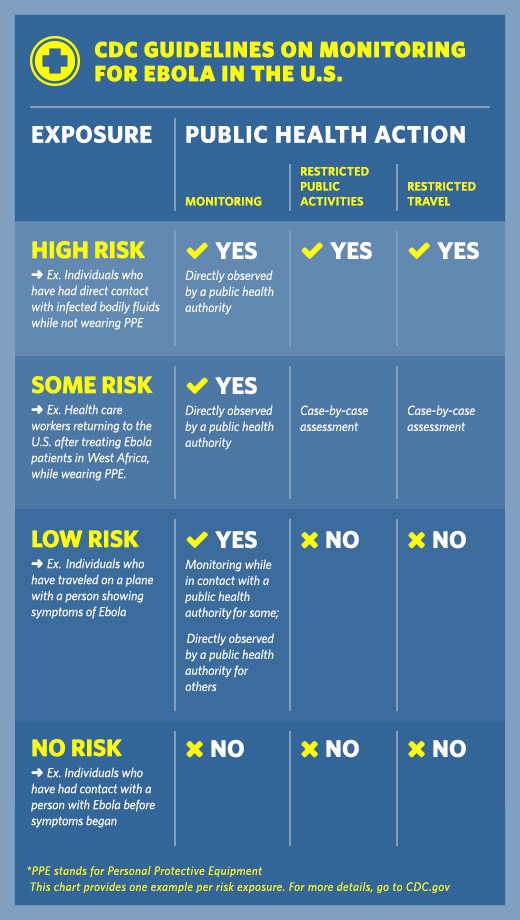
Ed. Note: This factsheet is cross-posted from the Centers for Disease Control and Prevention (CDC). Read the original factsheet in its entirety here.
Yesterday, based on the best medical science, the CDC updated its guidance to provide new information for public health officials on monitoring people who may have been exposed to Ebola; overseeing their care; and -- when warranted to protect the public health or our communities -- limiting their movement or activities.
These guidelines are crafted to keep the American public safe while not unnecessarily discouraging these workers from serving on the frontlines against this disease. They are heroes whose courage is worthy of our praise. Through these changes, we will help ensure that their symptoms are monitored and a system is in place to quickly recognize when they need to be routed to care. These actions will better protect potentially exposed individuals and the American public as a whole.
Key Changes to the Movement and Monitoring Guidance:
- New risk levels are given for people who may have been exposed to Ebola, as well as for those not at risk for the disease.
- The guidance recommends stricter actions for escalating levels of risk based on the type of exposure.
- State and local public health authorities are advised to use active monitoring or direct active monitoring rather than having people monitor themselves.
- Specific guidance is given about monitoring health care workers who cared for patients with Ebola in a country with widespread transmission, and people who visited an Ebola Treatment Unit in one of those countries.
- Specific guidance is also given about monitoring health care workers who provided care of patients with Ebola in the United States.
The new guidance defines four risk levels based on degree of exposure:
High risk -- direct contact of infected body fluids through:
- needle stick, or splashes to eyes, nose, or mouth
- getting body fluids directly on skin
- handling body fluids, such as in a laboratory, without wearing personal protective equipment (PPE) or following recommended safety precautions
- touching a dead body without correctly wearing PPE in a country with widespread Ebola transmission
- living with and caring for a person showing symptoms of Ebola
Some risk --
- Close contact -- or being within 3 feet for a long time without PPE -- with a person showing symptoms of Ebola such as in a household, health care facility, or the community
- In countries with widespread Ebola transmission: direct contact with a person showing symptoms of Ebola while wearing PPE
Low risk (but not zero) --
- having been in a country with widespread Ebola transmission within the previous 21 days and having no known exposure
- being in the same room for a brief period of time (without direct contact) with a person showing symptoms of Ebola
- having brief skin contact with a person showing symptoms of Ebola when the person was believed to be not very contagious
- in countries without widespread Ebola transmission: direct contact with a person showing symptoms of Ebola while wearing PPE
- travel on an airplane with a person showing symptoms of Ebola
No risk --
- contact with a person who is NOT showing symptoms AFTER that person was in contact with a person with Ebola
- contact with a person with Ebola BEFORE the person was showing symptoms
- having traveled to a country with an Ebola outbreak MORE than 21 days ago
- having been in to a country where there is no widespread Ebola transmission (e.g., the United States), and having no other exposures to Ebola
Public health officials will use these risk levels along with assessing symptoms to decide how best to monitor for symptoms and what other restrictions may be needed. The table on the following page provides further information about CDC’s recommended action for each risk level.
Recommended actions for symptomatic people with fever or other Ebola symptoms*
High, some, and low risk categories
These people MUST have a medical examination to make sure they don’t have Ebola. They will remain isolated in a hospital until doctors and public health officials are certain that Ebola is not a concern.
*Symptoms of Ebola: Fever, severe headache, fatigue, muscle pain, vomiting, diarrhea, stomach pain, unexplained bruising or bleeding.
No risk category
These people might need to have a medical examination for other diseases (not Ebola).
Recommended actions for people without symptoms

Definitions of Recommended Actions
Below are the definitions of actions that are recommended in the new guidance based on risk levels and symptoms. Public health actions, such as isolation of symptomatic people, active monitoring or direct active monitoring of people without symptoms, and travel restrictions when needed, help protect the public by preventing the spread of disease:
- Isolation separates sick people who are confirmed to have a contagious disease from people who are not sick.
- Direct active monitoring means that public health officials conduct active monitoring by directly observing the person being monitored. This means that a public health official directly observes the individual at least once a day to review symptoms and check temperature; a second follow-up per day can be done by telephone instead of being directly observed. Direct active monitoring should include discussion of plans to work, travel, take public transportation, or go to busy public places to determine whether these activities are allowed.
- Active monitoring means that public health officials are responsible for checking at least once a day to see if people have a fever or other symptoms of Ebola. People being monitored must take their temperature twice daily, watch themselves for symptoms, report as directed to public health officials, and immediately tell public health officials if they have a fever or other symptoms. Active monitoring must take place until 21 days after the last possible exposure and can occur on a voluntary basis or be required by legal order.
- Travel restrictions means that people must NOT travel by airplane, ship, or long-distance bus or train, even if they are NOT sick. The reason for this is to prevent possible spread of Ebola if the person develops fever or other symptoms during travel. People on travel restrictions might be allowed to travel by private plane or car as long as they continue to be monitored during travel. Taking local public transport should be discussed with the local health department.
New guidance for monitoring and determining exposure risk of returning health care workers to the U.S.
- Returning health care workers are heroes worthy of dignity and respect. Their efforts, along our civilian and military personnel in the region is what ultimately will enable us to eliminate the threat of additional domestic Ebola case.
- The high number of cases of Ebola among health care workers providing direct care to Ebola patients in countries with widespread transmission suggests that there are multiple potential sources of exposure to Ebola virus in these countries, including unrecognized problems with PPE, inadequate decontamination procedures, and exposure in patient triage areas. Due to this higher risk, these health care workers are classified in the some risk category, and additional precautions are recommended for them when they arrive in the United States.
New guidance for monitoring and determining exposure risk of health care workers in U.S. hospitals
- Even when U.S. health care workers who care for Ebola patients follow all the recommended PPE guidelines, they are still considered to be in the low risk level, because they might not realize they have been exposed. Therefore, all health care workers must have direct active monitoring.
- If a U.S. health care worker becomes sick with Ebola and it is not clear how the health care worker became exposed, then the other health care workers in that hospital who also took care of the Ebola patient are now considered exposed (high risk). This is because it would no longer be certain that all these health care workers had correctly followed the recommendations.
- If this happens, public health officials must review the hospital’s infection control practices, fix any problems identified, and retrain all the health care workers.


